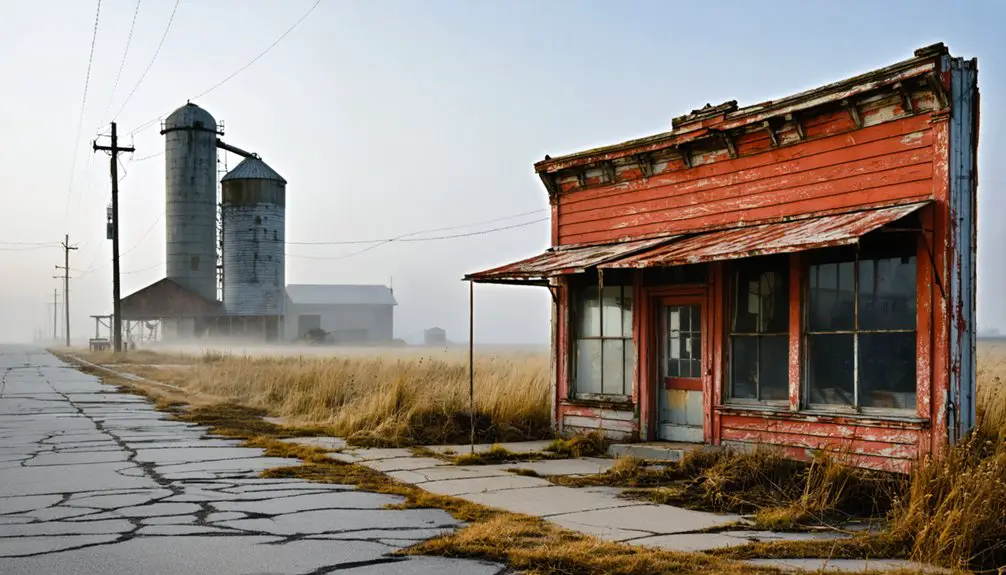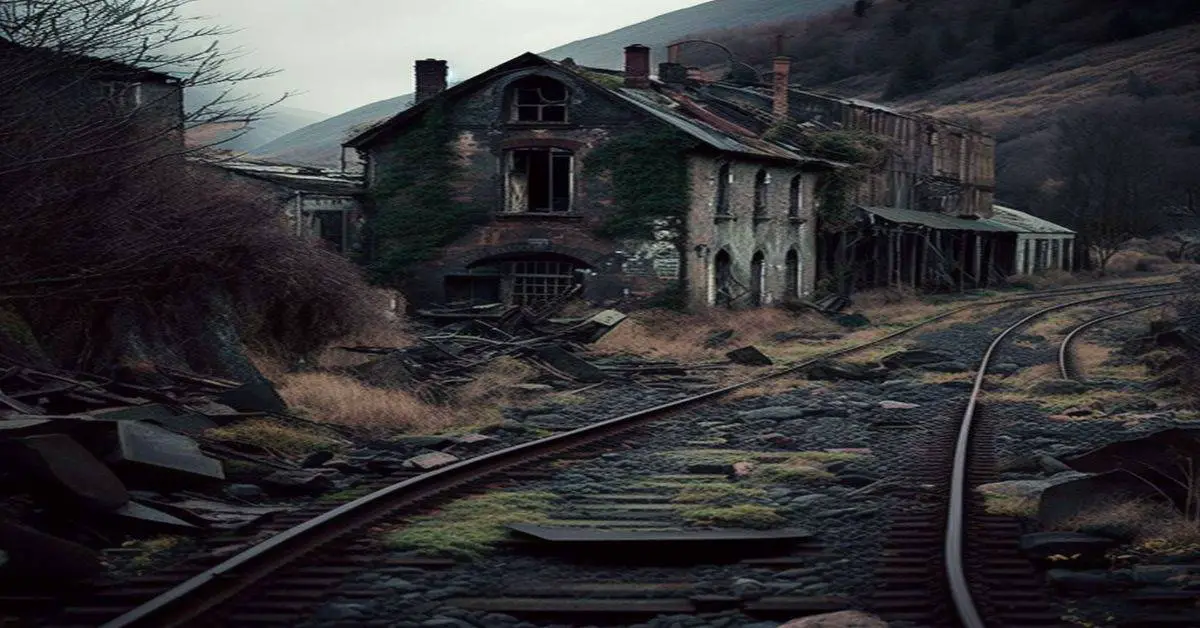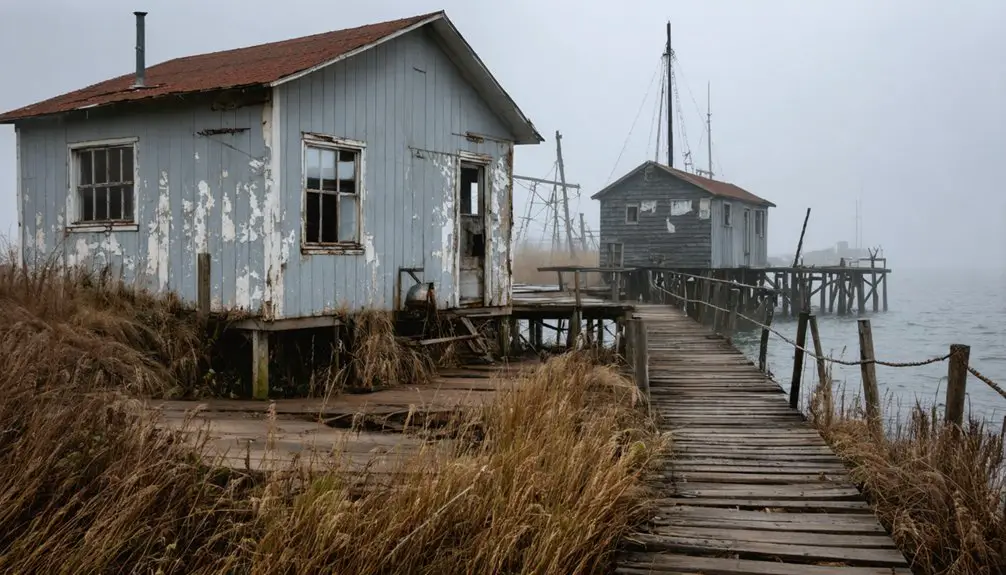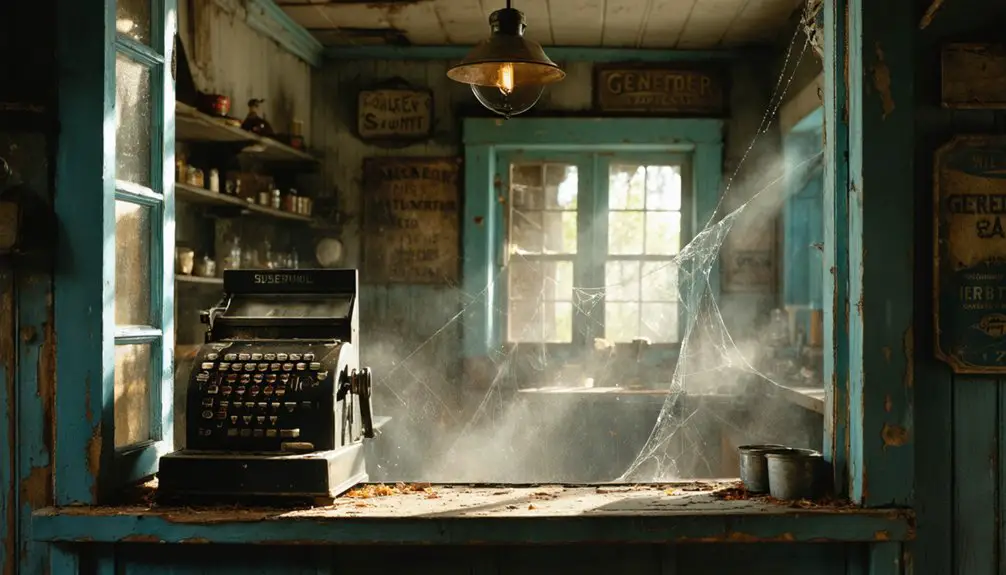You’ll discover Valley, Wisconsin along the Mississippi River, where it emerged as a bustling frontier settlement in 1836. The town thrived on mining, logging, and local commerce, with an opera house, trading posts, and taverns serving its growing population. Without essential railroad connections, Valley couldn’t compete with nearby rail-connected towns, leading to its abandonment by the early 1900s. Today, preservation efforts keep Valley’s frontier story alive through artifacts and oral histories.
Key Takeaways
- Valley emerged as a Wisconsin frontier settlement in 1836, thriving initially due to its sawmill, trading post, and natural resources.
- Lack of railroad access severely limited Valley’s economic growth while neighboring towns with rail connections prospered.
- The town’s economy collapsed after aggressive logging depleted timber resources and flooding from Dam #11 submerged parts of the village.
- Economic decline led to widespread abandonment as young residents left for urban opportunities, causing businesses and services to shut down.
- Local historical societies now preserve Valley’s cultural memory through exhibits, oral histories, and cemetery maintenance.
The Rise of a Frontier Settlement
As Wisconsin entered its territorial period in 1836, Valley emerged among numerous frontier settlements that dotted the region’s expanding landscape.
You’d find early European immigrants drawn to the area’s promise of rich natural resources and fertile land, facing pioneer challenges as they established their homes in the wilderness.
The settlement’s foundation centered around crucial frontier services – a sawmill, trading post, and stagecoach stop. Much like the bustling lead mining town of Gratiot’s Grove, Valley’s early economy focused on extracting local resources.
These significant outposts served the growing community while reflecting the cultural influences of its European settlers. Historical markers and cemeteries remained the only visible traces of the once-thriving settlement.
As more families arrived, they quickly established a post office and informal leadership structure, marking Valley’s shift from wilderness outpost to organized community.
The town’s future seemed promising, especially with the prospect of railroad connections that would determine the fate of many such frontier settlements.
Daily Life in Valley’s Peak Years
If you’d visited Valley during its bustling peak years, you would’ve found a town centered around essential gathering places like the opera house, amusement halls, and general stores.
You could’ve shopped for daily necessities at local meat markets or picked up supplies at businesses that served the mining and lumber trades.
The community’s social fabric was woven through these public spaces, where miners, farmers, and railroad workers gathered after long days of work to enjoy entertainment and maintain their close-knit bonds.
Like many towns from the Wild West era, Valley’s development was closely tied to local resource extraction and industrial growth.
Metal detecting enthusiasts must always obtain landowner permission before searching these historic sites for artifacts.
Community Gathering Places
While Valley may have lacked modern entertainment venues, its community gathering places formed the heart of local social life during the town’s peak years.
You’d find churches serving as primary hubs for social rituals, where Sunday services and prayer meetings brought neighbors together. Schools doubled as venues for town meetings and civic activities, while general stores buzzed with daily news and friendly chatter. The Wagon Wheel bar became a cherished meeting spot where locals shared stories and built lasting friendships.
Community events flourished in the town’s gathering spots. You could join harvest festivals at the community hall, watch local sports matches on makeshift fields, or attend dances that echoed with traditional music. Much like in nearby Pokerville, liquor and fights were common sights at local establishments.
The taverns and inns offered spaces to unwind after work, while bulletin boards and newspapers kept you connected to local happenings. These venues created the bonds that defined Valley’s close-knit community spirit.
Work and Commerce
During Valley’s peak years, you’d find a bustling economy driven by mining and logging operations, with quarrying becoming pivotal after the 1905 rock quarry opening.
Labor dynamics shifted rapidly as workers moved in and out of the area, responding to the demands of these resource-based industries. Similar to Ulao’s practice of selling 600 cords of wood to steamers per trip, Valley’s workers maintained a steady supply of raw materials. You’d encounter both skilled and unskilled laborers facing challenging conditions, often commanding higher wages due to the isolated location.
The commercial evolution of Valley matched its industrial growth. Walking down the main street, you’d pass general stores, meat markets, bakeries, and numerous saloons serving the hardworking population.
Local businesses thrived on workers’ needs, while railroads and improved roads connected Valley to external markets. When the primary industries began to decline, these commercial establishments followed suit, marking the beginning of Valley’s transformation into a ghost town.
Economic Forces Behind the Town
You’ll find Valley’s economic trajectory mirrored many Wisconsin ghost towns that relied heavily on single resources and transportation access.
Like many settlements, early transportation routes played a crucial role in the town’s initial development and ultimate decline.
As neighboring towns secured critical railroad connections in the 1870s, Valley’s isolation from major rail lines severely limited its ability to transport goods and maintain commercial activity.
The town’s dependence on small-scale farming operations proved unsustainable when agricultural consolidation and mechanization transformed the regional economy in the early 1900s.
This pattern continued into modern times as larger conglomerates acquired family farms, leading to further population decline and reduced economic activity.
Resource Dependency Cycles
As resource booms swept through Wisconsin in the late 1800s, Valley emerged as a prime example of the economic volatility that defined America’s resource-dependent towns.
You’d have witnessed rapid population growth as workers flooded in, drawn by high wages despite harsh conditions. The town’s resource cycles followed a predictable pattern: discovery, intensive extraction, and eventual depletion.
During boom times, Valley’s economy thrived with bustling saloons, general stores, and new housing construction.
But this economic sustainability proved fragile. When global commodity prices dropped or resources ran low, businesses shuttered and workers departed. The town’s fixed investments – buildings and infrastructure designed solely for extraction – couldn’t adapt to other industries.
Without economic diversification, Valley’s fate was sealed by its dependence on finite resources.
Transportation Network Impacts
While Native Americans and early European explorers initially relied on Wisconsin’s rivers and lakes for transportation, Valley’s economic fate became inextricably linked to evolving transport networks of the 19th century.
The transportation evolution from waterways to roads and railways dramatically shifted trade dynamics throughout the region. As four-wheeled vehicles gained prominence, wagon roads following former Indian trails connected Valley to crucial markets and military outposts.
However, the rise of railroads proved most decisive – towns with rail access thrived while others withered. You’ll find that Valley’s fortunes rose and fell with these transportation shifts, as the movement of agricultural products, raw materials, and finished goods depended heavily on reliable transport networks.
The presence or absence of stagecoach stops, warehouses, and rail connections ultimately shaped Valley’s economic trajectory.
Natural Resources and Industry
The natural resources of Valley, Wisconsin initially promised great prosperity through its vast timber reserves and proximity to the Mississippi River.
Valley’s rich forest lands and strategic river location seemed destined to bring lasting wealth to this Wisconsin settlement.
Without resource management or sustainable practices, the town’s logging industry rapidly depleted the forest cover, leaving behind degraded cutover lands.
You’ll find the town’s decline followed a predictable pattern:
- Aggressive logging operations stripped the land of valuable timber
- Failed attempts to convert cutover lands into productive farmland
- Flooding from Lock and Dam #11 construction submerged parts of the village
What you see today reflects the harsh reality of resource exhaustion.
After the timber industry collapsed, settlers couldn’t successfully farm the poor soil, and the Mississippi River’s fishing opportunities weren’t enough to sustain the community.
Valley’s story serves as a stark reminder of how unsustainable resource exploitation can doom a town’s future.
The town’s remaining landmarks include Virgin Mary’s crevice, which still draws occasional visitors to the abandoned site.
Transportation’s Impact on Valley
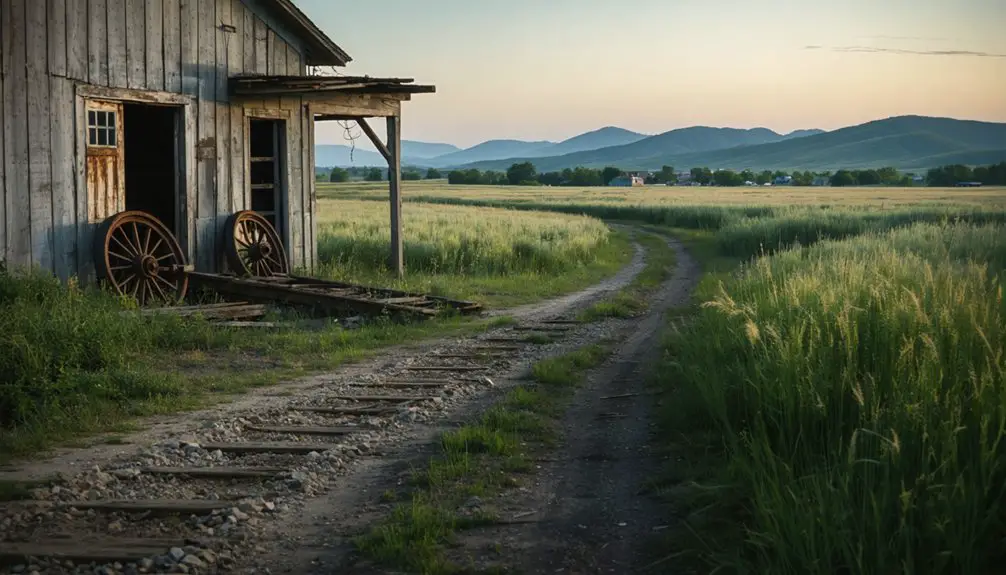
Despite Valley’s promising location near the Mississippi River, its lack of railroad access ultimately sealed the town’s fate.
While you could once witness the bustling river routes that early settlers and Native Americans used for transportation, these waterways couldn’t sustain the town’s growth as Wisconsin’s transportation evolution took hold in the mid-19th century.
You’d have seen the dramatic shift as railroad companies transformed the region’s landscape, bypassing Valley entirely.
While nearby towns with rail access thrived with their depots, hotels, and stockyards, Valley’s reliance on seasonal river transport became increasingly obsolete.
The town’s decline mirrored many other river-based communities that couldn’t adapt when lumber rafting ended and rail transport dominated.
Without a railroad connection, Valley couldn’t compete with rail-served towns, leading to its eventual abandonment.
The Process of Abandonment
As Valley’s economic foundation crumbled in the late 1800s, you’d have witnessed a gradual but relentless process of abandonment unfold.
The key abandonment triggers followed a predictable pattern that transformed this once-vibrant settlement into a ghost town.
The community’s decline progressed through these distinct phases:
When a town begins to fade, it follows clear stages of decline, each step drawing it closer to abandonment.
- Young residents left first, seeking better opportunities in growing urban centers.
- Essential services shut down as the population dwindled, including the post office and local shops.
- Remaining buildings deteriorated without maintenance, while harsh Wisconsin winters accelerated their decay.
You would’ve seen how the lack of economic diversification left Valley vulnerable.
When natural resources were depleted, the town couldn’t sustain itself.
Without a stable tax base or infrastructure investment, the ghost town characteristics became increasingly apparent as families relocated to more prosperous areas.
What Remains Today
Walking through Valley today, you’ll find a landscape that bears little resemblance to its bustling past. The town’s ghostly remnants include scattered building foundations, mostly hidden beneath decades of natural overgrowth. You can trace faint depressions in the earth where streets once carried horse-drawn wagons and early automobiles.
The most telling survivors are the small cemeteries, where weathered tombstones chronicle the area’s earliest settlers. Historical markers occasionally point out significant locations, though most structures have crumbled to rubble.
Local museums preserve found artifacts like tools and ceramics, protecting them from further decay. While the site lacks formal facilities, you’re free to explore the grounds, though you’ll need to navigate carefully around unstable ruins and unmarked rural roads.
Preserving Valley’s Legacy
While Valley’s physical structures have largely vanished, dedicated efforts to preserve its legacy continue through multiple channels. Local historians and historical societies work alongside descendants of original settlers to maintain Valley’s cultural memory through documentation, research, and community engagement.
Three key preservation efforts keep Valley’s story alive:
Valley’s rich history endures through dedicated preservation initiatives that ensure its stories and significance remain known to future generations.
- Regular family reunions and oral history collections from descendants help transmit personal narratives.
- Historical societies provide museum exhibits and maintain markers that contextualize Valley’s role in Wisconsin’s mining heritage.
- Academic research and published accounts document the settlement patterns and socio-economic forces that shaped Valley’s rise and decline.
You’ll find Valley’s legacy preserved through cemetery maintenance, archived photographs, and educational programs that connect visitors to this important piece of Wisconsin’s past.
Frequently Asked Questions
Were There Any Notable Crimes or Unsolved Mysteries in Valley’s History?
You won’t find documented historic crimes in Valley’s records, though nearby regions experienced unsolved disappearances. The town’s ghostly status adds mystery, but no confirmed criminal incidents exist in available archives.
What Happened to the Town’s Records and Important Documents?
You’ll find most record preservation efforts failed, as document loss occurred gradually through neglect, fires, and floods. Many official papers were dispersed when the town offices closed permanently.
Did Any Famous People or Historical Figures Visit Valley?
You won’t find any evidence of famous visitors or historical figures spending time here – records don’t show any notable people making their way to this remote settlement during its brief existence.
Are There Any Ghost Stories or Supernatural Legends About Valley?
You won’t find documented ghostly apparitions or haunted landmarks here – historical records don’t mention any supernatural legends. Like many Wisconsin ghost towns, stories focus on economic decline rather than paranormal activity.
How Many Residents Stayed in Valley Until Its Final Abandonment?
You’ll find it remarkable that like many fading towns, Valley’s final population remains unrecorded. Based on similar Wisconsin ghost towns’ patterns of decline, probably 25-30 families stayed until the very end.
References
- https://lakecountrytribune.com/exploring-the-haunting-echoes-of-wisconsins-ghost-towns/
- http://freepages.rootsweb.com/~gtusa/history/usa/wi.htm
- https://pbswisconsin.org/news-item/southern-wisconsins-ghost-towns-leave-behind-vital-stories/
- http://shunpikingtoheaven.blogspot.com/2016/05/a-wisconsin-ghost-town.html
- https://www.uwsp.edu/wp-content/uploads/2023/11/leaf-changing-of-the-land-lesson-5.pdf
- https://www.thevintagenews.com/2016/10/15/ghost-towns-in-dairyland/
- https://westernwisconsin.news/ghost-town-brookville/
- https://en.wikipedia.org/wiki/List_of_ghost_towns_in_Wisconsin
- https://www.geotab.com/ghost-towns/
- https://upnorthnewswi.com/2024/02/21/the-fascinating-stories-behind-7-wisconsin-ghost-towns/
